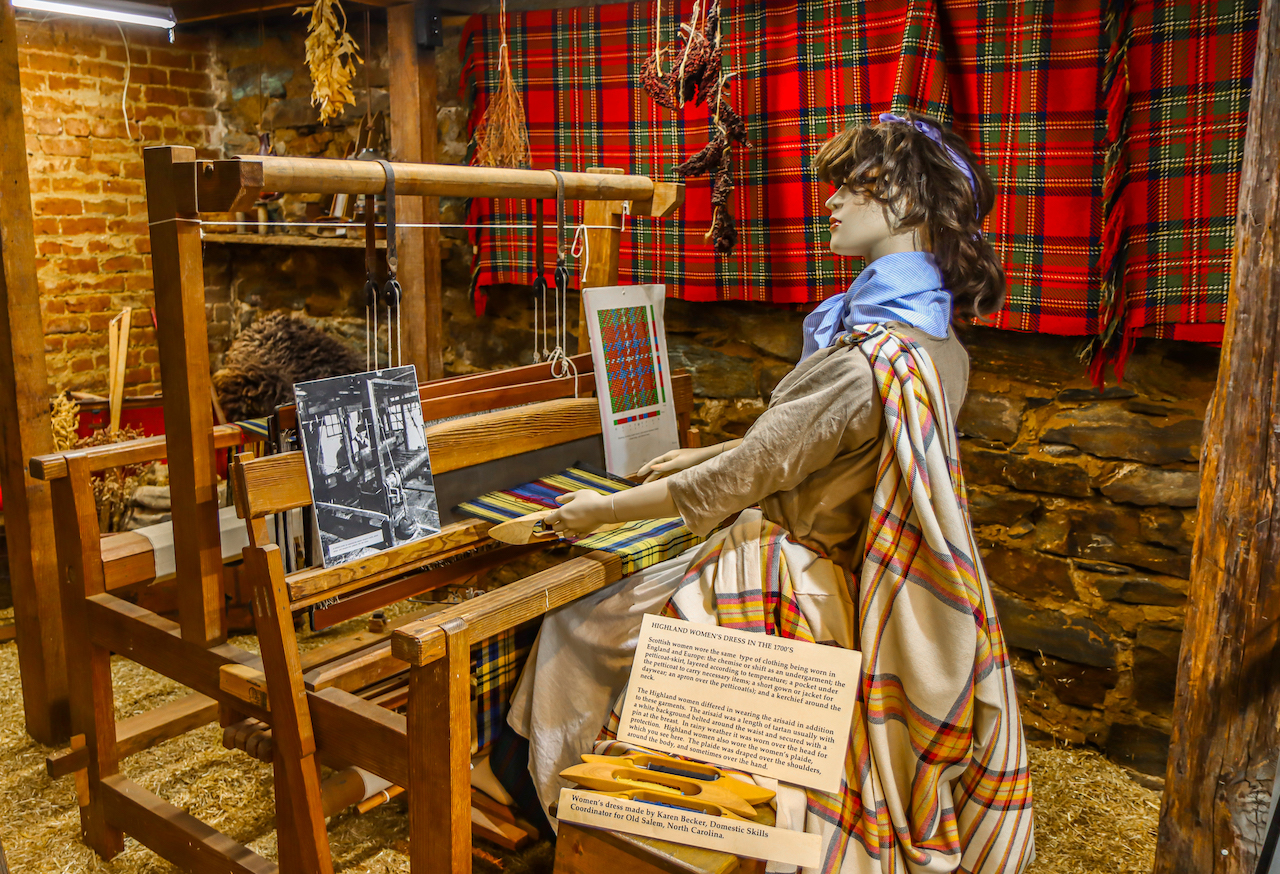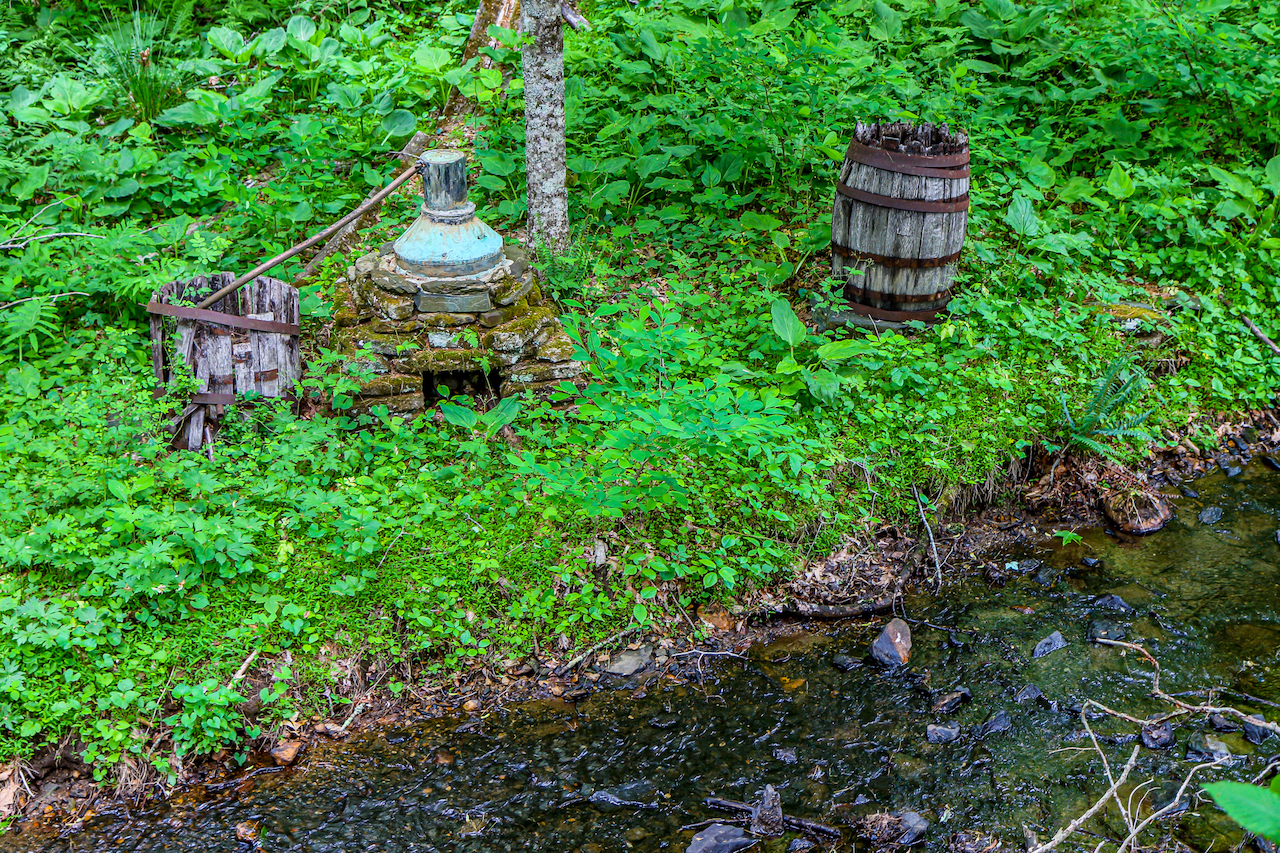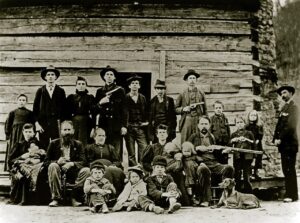“O Bessie Bell and Mary Gray, they were two bonnie lasses…”
Written by a long-forgotten author in the 1700s, this poem memorializes a haunting tale from Scotland about two young cousins who succumbed to the black plague.
There are countless other poems, songs, and stories that were brought to America by the Scots-Irish people.
Many of them have been woven into the history and culture of the southern Appalachian Mountains and the Blue Ridge Mountains.
In fact, you’ll find two peaks in the town of Staunton VA– now protected as the Betsy Bell and Mary Gray Wilderness Parks– which are the source of local legends (much like the Scottish poem).
There are currently an estimated 35 million Scots-Irish in America who descend from Ulster Protestants that emigrated from Ireland’s northernmost province in the 18th and 19th centuries.
Those early Scots-Irish settlers brought the agricultural, musical, crafting, and storytelling traditions of their homeland to the Appalachians.
Their influence remains prominent in many Blue Ridge Mountain towns today, from the Scottish Tartans Museum in Franklin NC to the Blairsville GA Scottish Festival and the Grandfather Mountain Highland Games.
Read on for 30 fascinating facts About Appalachian Scots-Irish history and culture, including the origin of the term “hillbillies,” famous Scots-Irish people in America, and more.
READ MORE: The 10 Best Things to Do in Franklin NC & Macon County

Appalachian Scots-Irish Facts Guide
- Facts About Scots-Irish History
- Facts About Scots-Irish People
- Facts About Scots-Irish Culture
- Scots-Irish in Appalachia & “Hillbillies”
- Famous Scots-Irish Americans
READ MORE: 25 Fun Facts About Tennessee History and Culture

Facts About Scots-Irish History
1. America’s Scots-Irish immigrants were mostly Presbyterians from southern Scotland. England’s King James I invited them to immigrate to Northern Ireland to displace the Catholic population and spread Protestantism in Ulster Ireland.
2. Many Ulster Scots (as they were called in England) left Ireland for America due to religious persecution from their Irish Catholic neighbors and Anglican English. The colonies also offered economic opportunities that were unavailable to them in Ireland.
3. Many Scots-Irish people arrived in Pennsylvania, then migrated south. Following the Great Wagon Road, the Scots-Irish settled in the Shenandoah Valley of Virginia, the Piedmont region of North Carolina, and South Carolina.
4. In the 1780 Battle of Kings Mountain, Scots-Irish frontiersmen were instrumental in defeating the British Loyalist forces. Theodore Roosevelt referred to this victory as the “turning point of the Revolutionary War.”
5. After the Revolutionary War, around 100,000 Scots-Irish immigrants arrived in America between 1783 and 1812, many of whom were skilled craftsmen. Another half-million came over between 1815 and 1845, and nearly twice as many arrived in the latter half of the 19th century.
READ MORE: The 20 Best North Carolina Hiking Trails

Facts About Scots-Irish People
6. Contrary to their name, the Scots-Irish people aren’t really of Irish descent. They are descendants of the Scottish people who lived in Ireland before emigrating to the American colonies.
7. The Scots-Irish immigration influenced America’s Declaration of Independence, which bears striking similarities to Scotland’s 1320 Declaration of Arbroath. The Declaration of Arbroath spoke of the sanctity of life and liberty, and asked the Pope to recognize Scotland’s independence, much as Americans declared independence from England in 1776.
8. The Scots-Irish people had independent spirits and a stubborn pride in their way of life. Many of them were farmers in Scotland, and had developed hair-trigger tempers and a fighter’s mentality to protect their livestock. These qualities served them well as frontiersmen settling in the rugged mountains of the Appalachian region.
9. President Andrew Jackson was born in Waxhaw SC to Scot-Irish immigrants in 1767. He fought in the American Revolution as a boy, studied law, and moved west to Tennessee in 1788. Jackson’s impact on American politics was so great that his time in office came to be known as the era of Jacksonian Democracy.
10. Scots-Irish people also played a major role in America’s Civil War. Generals Robert E. Lee and Ulysses S. Grant were both of Scottish descent. And BRMTG co-founder Bret Love’s ancestor, Lieutenant Col James R. Love II, led a battalion of Thomas’ Legion, a regiment of Cherokee Indians and Highlanders that fought in the war’s final battle.
READ MORE: The 10 Best Civil War Battlefields in Virginia to Visit

Facts About Scots-Irish Culture
11. Scots-Irish immigrants brought their tradition of home-brewed alcohol to the Appalachian Mountains. The most popular drink was an Irish/Scots recipe called uisce beatha, a Gaelic phrase meaning “the water of life.” This simple family mix was the beginning of moonshine!
12. The 1791 tax on whiskey was intended to raise much-needed revenue after the Revolution. Outraged, Scots-Irish farmers joined the Whiskey Rebellion, a violent resistance movement that lasted until 1794. Federal revenue collectors who ventured to the frontier were often beaten, tarred, and feathered.
13. Scots-Irish farmers were known for their skill in growing corn, potatoes, wheat, and barley, which became staples of the Appalachian diet. Smoking, salting, and drying meats are Scottish preservation techniques that are still used in Appalachian cooking today. Dishes such as cornbread, biscuits, and fried chicken all have Scots-Irish influence.
14. Appalachian speech is unique and rooted in many influences, including Scots-Irish words such as “britches” (trousers), “poke” (bag), or “afeared” (afraid). Language is integral to Appalachian folklore, and has evolved over the centuries from its original ethnic roots.
READ MORE: The Moon Eyed People & Other Cherokee Legends

15. Quilting was an artful craft born of necessity and scarcity. Quilts were made of discarded scraps of fabric, often left over from making a family’s clothing. With quilting, not a scrap was wasted, epitomizing the Appalachian Scots-Irish character of thrift.
16. Bluegrass pioneer Bill Monroe was from Kentucky, “the Bluegrass State.” With a strong emphasis on storytelling and instruments like the fiddle and banjo, bluegrass music is rooted in the Scots-Irish history of the Appalachian Mountains. It’s the folk music of Scotland and Ireland, with lyrics that spoke of lament and loss of their homeland.
17. Jack Tales are an oral storytelling tradition that originated in Ireland, of which Jack & the Beanstalk is the most famous example. Most of these tales follow a mischievous boy named Jack, who goes on an adventure to seek fortune. The Scots-Irish Appalachian culture had their own Jack Tales that were similar, and reflected frontier life.
18. Old Christmas, an Appalachian custom said to originate with the Scots-Irish settlers, was celebrated on January 6. Many people speculate that this was due to the isolation of the Appalachians, but others believe the independence of the Scots-Irish people made them hesitant to adopt the newer calendar that places Christmas on December 25.
READ MORE: 20 Ways to Celebrate Christmas in the Blue Ridge Mountains

Scots Irish in Appalachia & “Hillbillies”
19. The Scots-Irish brought a border culture of retributive justice to the Appalachians, forged by a centuries-long conflict between the Scottish, English, and Northern Irish. The infamous feud between the Hatfields & McCoys (who were of English and Scottish descent, respectively) reflects their territorial nature and combative culture.
20. Hillbillies, a term of derision often used for rural mountain folk in Appalachia, comes from the early Scots-Irish settlers. As supporters of King William of Orange, they were known as “Orangemen” and “Billy Boys.” Their counterparts in the Blue Ridge Mountains were soon referred to as “Hill-Billies.”
21. Scots-Irish moonshiners in Appalachia found Henry Ford’s sturdy V-8 coupe ideal for transportation of their products. It had a large trunk, and they learned to modify the engines to generate even more power and speed. Southern Appalachian moonshiners outrunning federal agents eventually led to stock car racing and NASCAR.
22. The “Bonnie Blue flag” is often associated with Scots-Irish in the south. In Sept 1810, Scots-Irish settlers raised the blue flag with a single white star after defeating a Spanish garrison in West Florida’s battle for independence. It was also flown as the national flag in North Carolina during the time of the Confederacy.
23. Scots-Irish brothers Barney and Ally Hartman created Mountain Dew in the 1940s. Mountain Dew was originally a slang term for Highland Scotch Whiskey, or moonshine. The lemon-lime soda was said to mix well with homemade whiskey, and Mountain Dew was marketed using the mascot “Willy the Hillbilly” until 1969.
24. The term Hillbilly was used in print as early as 1900. According to a New York Journal story, “A Hill Billy is a free and untrammeled white citizen of Alabama, who lives in the hills, has no means to speak of, dresses as he can, talks as he pleases, drinks whiskey when he gets it, and fires off his revolver as the fancy takes him.” Pop culture embraced hillbilly stereotypes with the Snuffy Smith comic strip and popular TV show The Beverly Hillbillies.
READ MORE: The 10 Best Things to Do in Mount Airy NC (a.k.a. Mayberry NC)

Famous Scots-Irish Americans
25. Famous pioneers Davy Crockett, Jim Bowie, and Daniel Boone were all of Scots-Irish descent. Crockett was known as “the King of the Wild Frontier,” Boone blazed the trail which became known as the Wilderness Road, and Bowie played a prominent role in the Texas revolution against Mexico, dying (along with Crockett) at the Alamo.
26. Inventor Cyrus McCormick, a Scots-Irish native of the Shenandoah Valley in Virginia, invented a mechanical reaper in the 1830s that could harvest 12 acres a day (vs. 1/2-acre per day of harvest by hand.) Some historians credit the reaper for helping to end the Civil War, since landowners no longer needed slaves to harvest their farms.
27. General Ulysses S. Grant, our nation’s 18th President, is famous for leading the Union Army to victory over the Confederates during the Civil War. As a two-term president of Scots-Irish ancestry, he worked to implement Congressional Reconstruction and to remove the vestiges of slavery.
28. Born as Samuel Langhorne Clemens, Mark Twain wrote 30+ books and hundreds of short stories, including The Adventures of Huckleberry Finn, which is considered the first Great American Novel. According to author Ernest Hemingway, “all modern American literature comes from one book by Mark Twain, Huckleberry Finn.”
29. Hank Williams’ influence on modern country music was so powerful, he was called “the Hillbilly Shakespeare.” His Scots-Irish heritage was a big factor in his development as an artist. William’s famous song “I Saw the Light” was set to the tune of a traditional Scottish folk tune, “Bonnie Charlie, Will Ye No Come Back Again.”
30. Jasper “Jack” Daniel got his start working for a Lynchburg TN moonshine distiller, Dan Call. Call’s African-American slave Nathan “Nearest” Green taught the poor, hard-working, and curious Scots-Irish boy how to make whiskey in a barnyard still. That boy grew up to open Jack Daniel’s Distillery in 1866, and hired the newly emancipated Nathan Green as his master distiller! –by Heather Taylor and Jon Weaver


